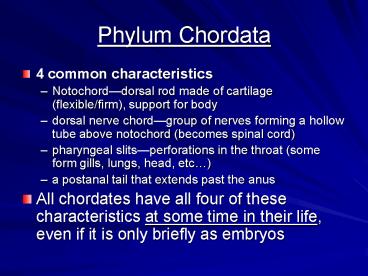Phylum Chordata PowerPoint PPT Presentation
1 / 19
Title: Phylum Chordata
1
Phylum Chordata
- 4 common characteristics
- Notochorddorsal rod made of cartilage
(flexible/firm), support for body - dorsal nerve chordgroup of nerves forming a
hollow tube above notochord (becomes spinal cord) - pharyngeal slitsperforations in the throat (some
form gills, lungs, head, etc) - a postanal tail that extends past the anus
- All chordates have all four of these
characteristics at some time in their life, even
if it is only briefly as embryos
2
Typical Chordate Representation
3
Chordates continued
- There are three subphyla of Phylum Chordata
- There are two subphylas of invertebrate
chordates Tunicates and Lancelets - One large subphylum Vertebrata
4
Tunicates
5
Lancelets
6
Sub Phyla- Vertebrata
- Dorsal Nerve Cord
- Vertebrates
- Regionalized Brain
- Bilateral
- Systems Interact
- Classes
- Agnatha -- Chondrichthyes -- Osteichthyes
- Amphibia -- Reptilia -- Aves -- Mammalia
7
Subphylum Vertebrata (Vertebrates)
- 44,000 species, found on land, fresh and marine
water - Segmented vertebral column (backbone) replaces
notochord, surrounds/protects nerve chord - Endoskeleton made up of living cells and tissues
(allows growth, large size), jaws (efficient way
of eating) - Distinct head and brain inside skull, gill slits
remain or are modified during development - Interaction of muscular, skeletal, and nervous
system leads to greater speed and agility
8
Fishes have
- Endoskeletons
- cartilage or bone
- Breathe with gills
- Closed-loop circulation
- Kidneys
- Aquatic
- Cold blooded (ectotherms)
- 3 main existing classes
9
Jawless Fish
- First vertebrates
- No scales
- Retain notochord
- Lamprey, hagfish
- Cartilage endoskeleton
10
Cartilaginous Fish
- Cartilaginous fish
- No swim bladder
- Tooth-like scales
- Internal fertilization with live birth
Sharks, rays, skates
11
Bony Fish
- Bony endoskeleton
- Scales
- Lateral line system
- Swim Bladder
- Opercula
12
Tetrapods
- Presence of 4 appendages
- Ancestor may have been the lobe-finned fish
13
Amphibians
- First to live on land
- Cutaneous Respiration
- Life in water/on land
- Lungs
- Water for reproduction
14
Frog Life Cycle
15
Reptiles
- Dry skin, scales
- Internal fertilization
- Amniotic egg
- Lungs
- Ectothermic
16
Birds
- Endothermic
- 4 chambered heart
- Feathersmodified scales
- Light, hollow bones for flight
17
Mammals
- Mammary glands
- Endothermic
- Specialized teeth
- Internal Feritlization
- Hair
18
3 Mammalian Orders
- 1) Marsupials- young born at immature stage and
complete development in pouch - 2) Monotremes- egg-laying, oviparous
- 3) Placentals- develop completely inside uterus,
nourished by the placenta - 95 of mammal species are placental
19
Class Mammalia

